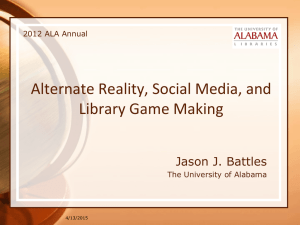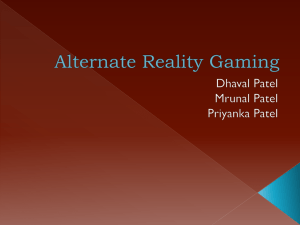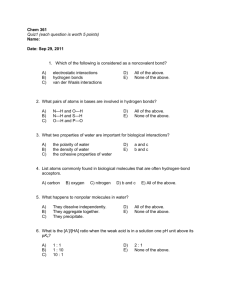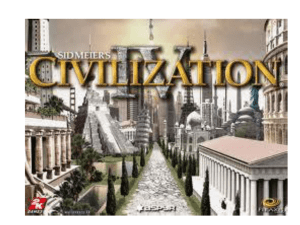LibraryGame
advertisement
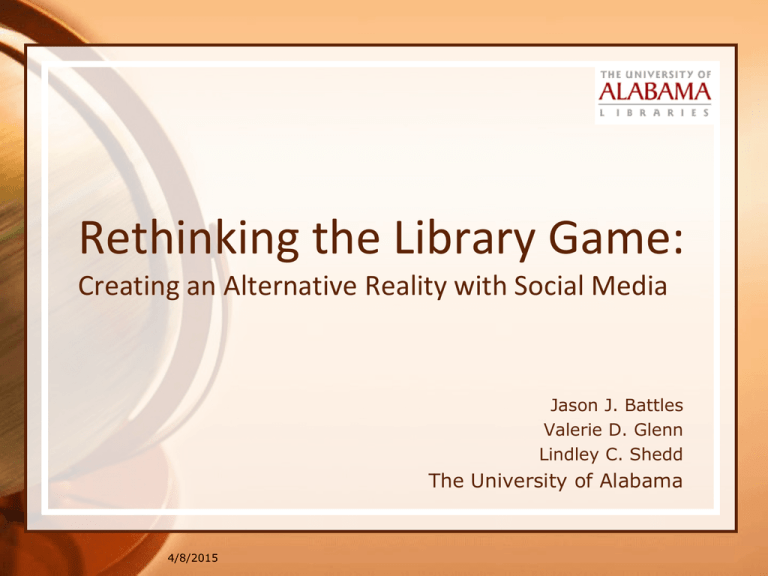
Rethinking the Library Game: Creating an Alternative Reality with Social Media Jason J. Battles Valerie D. Glenn Lindley C. Shedd The University of Alabama 4/8/2015 Libraries and Gaming • Gaming in Libraries • Wii, DDR, Rock Band, board games • Libraries in Games • Second Life • Library Games • General focus on information literacy 4/8/2015 Libraries and Gaming • Why create a library game? • Promote information literacy • Highlight library resources • Engage users • Don’t we need a programmer? • No. You just need creative staff members, clear game objectives, and web skills. 4/8/2015 Learning Objectives of the Game • Highlight resources and collections • Special Collections • Electronic Journals • Online Course Reserves • Initiate students on how to access and search these resources • Encourage critical thinking of participants 4/8/2015 What Will Engage Students? • “Academic Games Are No Fun” • http://games.slashdot.org/games/07/12/05/13023 3.shtml • Games they play • Halo and Call of Duty • MMOGs like World of Warcraft • Guitar Hero and Rock Band • Online sites they use • Facebook • YouTube • Twitter 4/8/2015 4/8/2015 4/8/2015 4/8/2015 Finding the Right Game Format • Libraries cannot directly compete with most commercial games • Determine your available resources • Financial • Human • Incorporate popular social media sites to engage students where they are • Develop manageable game objectives and a strong concept to keep players 4/8/2015 Alternate Reality Games (ARG) • Web-based and story-driven design • Disguises the fact that it is a game at all • No defined rules • Runs over a fixed period of time • Player reveals the plot and goals through interacting with game components 4/8/2015 Alternate Reality Games (ARG) • http://www.argn.com • This is Not a Game by Dave Szulborski • Internet-based and story driven • Examples: • http://www.massivedynamic.com/ • http://www.marevitreum.com/ • http://www.tracesofhope.com/ • Indiana University’s ARG work • 4/8/2015 http://www.argn.com/2008/09/indiana_university_combat s_the_freshman_fifteen_with_skeleton_chase/ Why an ARG? • Non-traditional approach that is more engaging for players • Does not require large budgets or a team of programmers • Social media sites are natural locations for game components • ARGs have been successful in marketing movies, television shows, and video games • Why not libraries? 4/8/2015 Our Game - Project Velius 4/8/2015 Considerations in Building our ARG • Development directed by diverse team of library personnel with limited resources • No additional funding • No team of programmers • Limited student work allotment • Game must be completely online • Game should be accurate representation of how library resources are accessed and used 4/8/2015 Building an ARG • Story creation is the most important element of ARGs, but it is also the most difficult • The story plays out like a screenplay • The creation of game assets is dependent on the creation of the storyline 4/8/2015 Project Velius Storyline • Developed over several months by three committee members • Main character and her boyfriend work at a biotech company • He goes missing • She uses clues found in library resources and social media venues to find him 4/8/2015 Our Game – Project Velius • http://www.projectvelius.com • Library Resources • Unique historical collection • Electronic journal article • Online course reserves • Social Media Components • Web sites 4/8/2015 Social Media Components • Facebook group • Served as the hub of the game • Facilitated player interaction • Twitter accounts • YouTube video • WordPress blogs 4/8/2015 4/8/2015 http://www.youtube.com/watch?v =WJwnsWaBpCc 4/8/2015 Web Sites • www.projectvelius.com • Main gateway for the game • www.yenosresearch.com • Fake biotech corporation involved in a questionable research program • www.knowgarden.org • Student homework site that was only discoverable through game clues 4/8/2015 4/8/2015 4/8/2015 4/8/2015 Running the Game 4/8/2015 Running the Game • Ran over a six week period from September 17 to October 22, 2009 • Blogs and Twitter were the main tools used for character interaction • Members of the development group took on the roles of the characters 4/8/2015 Running the Game - Continued • These puppeteers made blog posts and tweets timed by a detailed script • They also built the story’s alternate reality through backdated blog entries • One person served as a game master to help players via the Facebook group 4/8/2015 4/8/2015 Marketing • No carrot • Flyers, news ad, web ad • Bibliographic Instruction sessions • Freshman compass courses • English 101 4/8/2015 4/8/2015 Assessment • Web stats • Google Analytics • WordPress • Survey of players • End of game event 4/8/2015 Lessons Learned • Start with a bang! • Keep them interested • Resist controlling the tempo or gating player progression • Consider the length of the game • Build something you can easily replicate • Find collaborations to help with aspects of the game that are not your strength 4/8/2015 Lessons Learned - Continued • Understand the limitations and use policies of any social media tools you intend to employ • Think about the need to track players • Create buy-in among the campus community 4/8/2015 Next Steps • Follow advancements in technology, gaming, and instruction • Continue to examine what motivates players in games • Find ways to include students in the creation and development • Consider external collaborations 4/8/2015 Contact Information Jason J. Battles jjbattles@ua.edu Valerie Glenn vglenn@ua.edu Lindley Shedd lcshedd@ua.edu 4/8/2015
